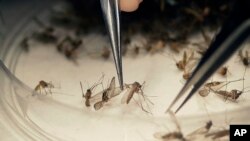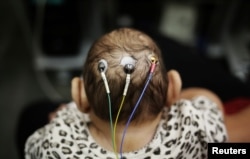A team of researchers based at Harvard University say they have developed a testing method that could quickly diagnose Zika virus, and do so basically anywhere in the world.
The Zika outbreak first hit the Western Hemisphere a year ago with reports of infections in Brazil. Some 57 countries and territories are now reporting cases of people being infected, most by mosquitoes that can carry the Zika virus. Several countries also have reported cases that appear to have spread through sexual contact.
The World Health Organization says there is scientific consensus that Zika is a cause of both the birth defect microcephaly in infants and the nervous system disorder Guillain-Barre syndrome. Most of the affected countries are in Latin America and the Caribbean, and the WHO says if the pattern spreads elsewhere the world faces a severe public health crisis.
Building on work they did to develop a screening method for Ebola, the researchers led by synthetic biologist James Collins came up with a way to screen blood, urine or saliva for Zika virus.
In a paper published in the journal Cell, they said previous techniques such as looking for antibodies in body fluids are limited because people could have antibodies from similar viruses present in the region such as Dengue. Other methods are expensive and require equipment that is not readily available in many areas.
Their method uses paper cards about the size of a human hand that contain freeze-dried biomolecular components. Because the concentration of Zika virus in the blood is very low, the researchers first amplify the sample through a process that triggers the virus to multiply. The amplified sample is then applied to the paper card, and if Zika is present, the card changes color.
Samples from any positive test can then be applied to another card that is set up to determine which of the many strains of Zika virus is present.
The testing can produce a result in as little as 30 minutes with the change in color easily visible to the naked eye. An even faster result can be achieved by placing the card in a special reader, the researchers say.
"The freeze-dried molecular components remain stable at room temperature, allowing for easy storage and distribution in global settings," the paper says.
In addition to its potential application in a variety of settings, the researchers say their method is also a lot cheaper than others used to detect Zika.
"We are currently pursuing multiple opportunities to secure private and public funding in order to commercialize this diagnostic system and make it available to the world's health responders," Collins said.
There is no vaccine for Zika. The WHO says developers in the U.S., France, Brazil, India and Austria are currently working on 23 different projects in order to develop one. The agency expects some of them to be at the stage of clinical trials by the end of the year, but that a fully tested vaccine may not be available for several years.
In the meantime, efforts to halt the virus are focused on controlling the mosquitoes that carry it. The WHO says half of the world's population lives in areas where the Aedes aegypti mosquito does too.











